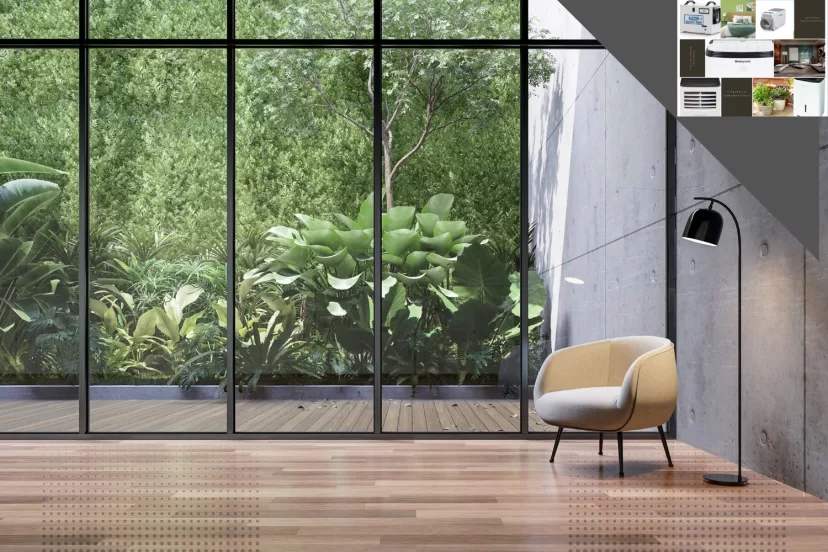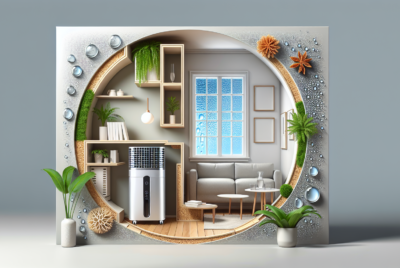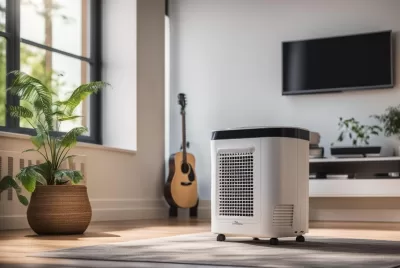Room Dehumidifiers: Transforming Your Home
"We may earn a commission for purchases made using our links. Please see our disclosure to learn more."
Room Dehumidifiers: Transforming Your Home into a Perfect Ambiance
When it comes to creating a comfortable living space, humidity levels can play a significant role. High humidity can lead to discomfort, mold growth, and other issues, making it important to control the moisture levels in a room. One popular solution is using room dehumidifiers, which can help to reduce humidity and create a more comfortable environment.
Room dehumidifiers work by drawing in air from the surrounding environment and removing excess moisture. They can be particularly useful in areas that are prone to high humidity, such as basements or bathrooms. By reducing the moisture levels in the air, dehumidifiers can help to prevent mold growth, reduce allergens, and improve indoor air quality.
While there are many different types of room dehumidifiers available on the market, they all operate on the same basic principle. Some models are better for larger spaces and others for small rooms or specific applications.Understanding the different types of dehumidifiers and how they work can help you to choose the best option for your needs.
Understanding Room Dehumidifiers
Room dehumidifiers are appliances that remove excess moisture from the air inside a room. They work by drawing in air and passing it over a cooling coil, which removes the moisture and collects it in a drip tray.
People commonly use dehumidifiers in areas with high humidity levels or where moisture poses a problem, like basements, bathrooms, and laundry rooms.
Two factors determine the dehumidifier’s capacity, measured in pints per 24 hours: the size of the space needing dehumidification and the conditions present in the space before dehumidification. According to the Association of Home Appliance Manufacturers (AHAM), a 30-pint dehumidifier can effectively dehumidify a room up to 1,500 square feet, while a 70-pint dehumidifier can handle a room up to 4,000 square feet.
When choosing a dehumidifier, it is important to consider the size of the room, the level of humidity, and the intended use. For example, a small dehumidifier may be suitable for a closet or small bathroom, while a larger dehumidifier may be necessary for a basement or large living area.
Dehumidifiers offer several benefits, including reducing the risk of mold and mildew, improving air quality, and reducing energy costs. By removing excess moisture from the air, dehumidifiers can help prevent the growth of mold and mildew, which can cause health problems and damage to the home. They can also improve air quality by reducing the number of allergens and irritants in the air, such as dust mites and pollen.
In addition, dehumidifiers can help reduce energy costs by making the air feel cooler and more comfortable, allowing homeowners to set their thermostats at a higher temperature without sacrificing comfort. This can lead to significant energy savings over time.
Overall, a dehumidifier can be a valuable addition to any home, providing improved comfort, air quality, and energy efficiency.
Types of Room Dehumidifiers
When it comes to selecting a room dehumidifier, there are several types to choose from. Each type has its own unique features and benefits. In this section, we will explore the three most common types of room dehumidifiers: refrigerant dehumidifiers, desiccant dehumidifiers, and whole-house dehumidifiers.
Refrigerant Dehumidifiers
Refrigerant dehumidifiers, also known as compressor dehumidifiers, are the most common type of dehumidifier. They work by drawing in humid air and passing it over cold coils. The moisture in the air condenses on the coils and drips into a collection tank or drain. The device reheats the dry air and releases it back into the room.
Refrigerant dehumidifiers are ideal for use in areas with temperatures above 60°F and humidity levels above 50%. They are effective at removing large amounts of moisture from the air and are suitable for use in large rooms and basements. However, they can be noisy and consume a lot of energy.
Desiccant Dehumidifiers
Desiccant dehumidifiers use a different method to remove moisture from the air. They use a desiccant material, such as silica gel, to absorb moisture.
The desiccant material absorbs moisture as the device passes humid air over it and then releases dry air back into the room.
People find desiccant dehumidifiers ideal for areas with temperatures below 60°F and low humidity levels. They operate more quietly and use less energy than refrigerant dehumidifiers. However, they don’t remove large amounts of moisture from the air as effectively and work best in small rooms.
Whole House Dehumidifiers
Whole house dehumidifiers are designed to remove moisture from the air throughout an entire home.
They draw humid air into the HVAC, pass it over a refrigerant coil, and condense moisture. The dry air then circulates back.
Whole house dehumidifiers suit high-humidity areas and maintain consistent home humidity. They cost more but are efficient in the long run.
Choosing the right dehumidifier depends on room size, humidity, and energy efficiency. Knowing different types helps you decide best.
Factors to Consider When Buying
When looking to purchase a room dehumidifier, there are several factors to consider to ensure that you get the right unit for your needs. Here are some important factors to keep in mind:
Size of the Room
One of the most important factors to consider when buying a dehumidifier is the size of the room it will be used in. If the room is too large for the dehumidifier, it won’t be able to effectively remove moisture from the air. On the other hand, if the dehumidifier is too large for the room, it will cycle on and off frequently, which can be noisy and inefficient.
To determine the appropriate size of the dehumidifier, consider the square footage of the room. As a general rule of thumb, a 30-pint dehumidifier is suitable for a room up to 1,500 square feet, while a 50-pint dehumidifier is appropriate for a room up to 3,000 square feet. Larger rooms may require a 70-pint or higher dehumidifier.
Humidity Level
Another important factor to consider when purchasing a dehumidifier is the humidity level of the room. If the humidity level is consistently high, a higher-capacity dehumidifier may be required to effectively remove moisture from the air.
To determine the appropriate capacity of the dehumidifier, consider the relative humidity level of the room. A hygrometer measures humidity. A dehumidifier with one can auto-adjust settings for desired humidity.
Energy Efficiency
Energy efficiency is an important consideration when purchasing a dehumidifier, as it can affect both the environment and your wallet. Look for dehumidifiers with the ENERGY STAR certification, as these units are designed to use less energy than standard models.
In addition, consider the unit’s power consumption and operating costs. A dehumidifier that runs continuously can quickly add up in energy costs, so look for units with energy-saving features such as automatic shut-off or programmable timers.
Noise Level
Finally, consider the noise level of the dehumidifier. While all dehumidifiers produce some level of noise, some models are quieter than others. Look for units with noise levels of 50 decibels (dB) or lower, as these units are considered to be relatively quiet.
In addition, consider the placement of the dehumidifier. Placing the unit in a closet or other enclosed area can help to reduce noise levels, while placing the unit in a larger room may result in increased noise levels.
Installation and Maintenance of Room Dehumidifiers
When it comes to installing and maintaining room dehumidifiers, there are a few key things to keep in mind. Proper placement, regular cleaning, and timely repairs are all important factors that can impact the effectiveness and lifespan of your dehumidifier.
Proper Placement
The placement of your dehumidifier can have a significant impact on its effectiveness. It’s important to place your dehumidifier in a central location within the room, away from walls and furniture, to allow for maximum air circulation. Avoid placing it near sources of heat or cold, such as windows or air conditioning units, as this can affect the accuracy of the humidity readings and reduce its efficiency.
Regular Cleaning
Regular cleaning is essential to ensure that your dehumidifier is functioning at its best. The coils and filters should be cleaned or replaced at least once a year, or more frequently if you live in a particularly humid environment. A dirty or clogged filter can reduce the airflow and cause the dehumidifier to work harder, leading to higher energy bills and a shorter lifespan. Additionally, the water bucket should be emptied and cleaned regularly to prevent the growth of mold and bacteria.
Timely Repairs
If your dehumidifier is not functioning properly, it’s important to address the issue as soon as possible. Common problems include a malfunctioning compressor, faulty humidistat, or a clogged drain. If you notice any of these issues, it’s best to contact a professional for repairs. Delaying repairs can lead to further damage and potentially shorten the lifespan of your dehumidifier.
In summary, proper placement, regular cleaning, and timely repairs are all important factors to consider when installing and maintaining a room dehumidifier. By following these guidelines, you can ensure that your dehumidifier is functioning at its best, providing a comfortable and healthy environment for you and your family.
Benefits of Using Room Dehumidifiers
Room dehumidifiers are a popular choice for homeowners who want to maintain a comfortable and healthy indoor environment. By removing excess moisture from the air, these devices offer several benefits that can improve the overall quality of life in a home. Here are some of the key benefits of using room dehumidifiers:
Prevents Mold and Mildew
One of the most significant benefits of using a room dehumidifier is that it helps to prevent the growth of mold and mildew. These fungi thrive in damp, humid environments, and can cause serious health problems for people who are exposed to them. By reducing the humidity levels in a room, a dehumidifier can help to prevent the growth of mold and mildew, which can help to protect the health of everyone in the home.
Improves Air Quality
Another benefit of using a room dehumidifier is that it can help to improve the overall air quality in a home. When the air is too humid, it can become stagnant and musty, which can make it difficult to breathe and cause unpleasant odors. By removing excess moisture from the air, a dehumidifier can help to improve the circulation of fresh air in a room, which can make it easier to breathe and reduce odors.
Protects Home Infrastructure
Finally, using a room dehumidifier can help to protect the infrastructure of a home. When the air is too humid, it can cause damage to walls, floors, and other surfaces, which can be expensive to repair. By reducing the humidity levels in a room, a dehumidifier can help to prevent damage to these surfaces, which can help to save homeowners money in the long run.
Overall, using a room dehumidifier can offer several benefits that can improve the overall comfort and health of a home. By preventing the growth of mold and mildew, improving air quality, and protecting home infrastructure, these devices are an excellent investment for anyone who wants to maintain a healthy and comfortable indoor environment.
Potential Drawbacks
While room dehumidifiers offer several benefits such as reducing moisture and eliminating mold and other airborne allergens, they also come with a few potential drawbacks that should be considered before making a purchase.
Energy Consumption
One of the major drawbacks of using a room dehumidifier is its energy consumption. According to Home Air Geeks, dehumidifiers draw in air, extract moisture, and release dry air into your living space. This process requires energy, which can result in a higher electricity bill. However, some dehumidifiers come with energy-saving features that can help reduce energy consumption.
Noise Production
Another potential drawback of using a room dehumidifier is noise production. As dehumidifiers work to extract moisture from the air, they can produce noise that can be disturbing, especially if used in a bedroom or other quiet space. According to Unhappy Hipsters, some dehumidifiers are quieter than others, and it’s important to consider noise levels when choosing a dehumidifier. Additionally, some dehumidifiers come with noise-reducing features that can help reduce noise production.
In summary, while room dehumidifiers offer several benefits, they also come with a few potential drawbacks such as energy consumption and noise production. It’s important to consider these factors when choosing a dehumidifier to ensure that it meets your needs and requirements.
Conclusion
In conclusion, room dehumidifiers are a useful tool for controlling the humidity levels in a space. They work by removing excess moisture from the air, which can help prevent mold growth, reduce allergens, and improve indoor air quality.
When selecting a dehumidifier, it is important to consider the size of the space, the desired moisture removal capacity, and the noise level of the unit. The Midea 50 Pint Cube and the Frigidaire Gallery FGAC5044W1 are both excellent options for larger spaces, while the Frigidaire FFAD2233W1 is a good choice for smaller rooms.
It is also important to properly maintain and clean the dehumidifier to ensure optimal performance. This includes regularly emptying the water tank, cleaning the filter, and ensuring proper ventilation.
Overall, a room dehumidifier can be a valuable investment for those looking to improve the comfort and air quality of their living space. By controlling humidity levels, it can help prevent damage to furniture and other items, reduce the risk of respiratory issues, and create a more pleasant living environment.




